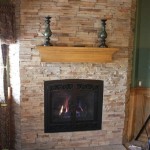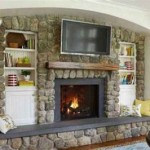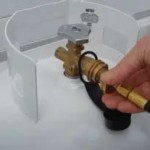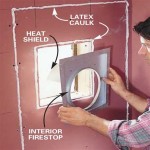```html
Cleaning a Gas Fireplace: A Comprehensive Guide
Gas fireplaces offer the ambiance and warmth of a traditional fire without the hassle of wood gathering and ash disposal. However, even though they burn gas, regular maintenance, including cleaning, is essential to ensure optimal performance, efficiency, and safety. Accumulation of dust, debris, and soot can affect the burner's efficiency, reduce flame quality, and potentially lead to safety hazards. This article provides a detailed guide on how to safely and effectively clean a gas fireplace.
Key Points for Gas Fireplace Cleaning:
- Safety First: Always prioritize safety by disconnecting the gas supply and ensuring the fireplace is cool before starting any cleaning procedure.
- Thorough Cleaning: A comprehensive cleaning process involves removing and cleaning the glass door, logs, burner, and firebox interior.
- Regular Maintenance: Regular cleaning, even if minor, will prolong the life of the fireplace and ensure optimal performance.
Prioritizing Safety: Gas and Electrical Disconnection
Before commencing any cleaning activity, safety is paramount. The first and most crucial step is to disconnect the gas supply to the fireplace. Locate the gas shut-off valve, usually situated near the fireplace or in the basement, and turn it off. This prevents any accidental gas leaks during the cleaning process. Secondly, if the fireplace has an electrical connection, unplug it from the power outlet or switch off the circuit breaker that controls the fireplace. This eliminates the risk of electrical shock. Allow the fireplace to cool down completely before proceeding. Working on a hot fireplace can cause burns and damage to components.
Glass Door Cleaning: Removing Soot and Film
The glass door of a gas fireplace is often the most visible part and accumulates soot and film over time. To clean the glass, carefully remove the door, usually by releasing clips or screws holding it in place. Consult the fireplace's manual for specific instructions on door removal. Once removed, lay the door flat on a protected surface, such as a drop cloth or newspaper. Use a specialized fireplace glass cleaner or a mixture of mild soap and water. Avoid using abrasive cleaners, as they can scratch the glass. Apply the cleaner to the glass and wipe it thoroughly with a soft cloth or paper towel. For stubborn soot, a razor blade can be used carefully at an angle to scrape it off, followed by wiping with a glass cleaner. Ensure the glass is completely dry before reattaching the door to the fireplace.
Cleaning the Logs: Preserving Aesthetics and Burn Quality
Gas fireplace logs are typically made of ceramic or refractory cement and are designed to mimic the appearance of real wood. Over time, these logs can accumulate dust, soot, and carbon deposits. To clean the logs, carefully remove them from the firebox, noting their original placement to ensure proper airflow when reinstalled. Use a soft brush or vacuum cleaner with a brush attachment to remove loose dust and debris. For stubborn soot, gently wipe the logs with a damp cloth. Avoid using harsh chemicals or soaking the logs in water, as this can damage their finish and integrity. Allow the logs to dry completely before placing them back into the fireplace. Ensure the logs are positioned according to the manufacturer's instructions to maintain proper flame patterns and ventilation.
Burner Cleaning: Maintaining Efficient Gas Flow
The burner is the heart of the gas fireplace, responsible for mixing gas and air to create the flame. A clogged or dirty burner can lead to uneven flames, reduced heat output, and potential safety hazards. To clean the burner, carefully remove it from the firebox. Consult the fireplace's manual for specific instructions on burner removal. Use a wire brush or pipe cleaner to clear any debris or obstructions from the burner ports. Compressed air can also be used to blow out any remaining particles. Be gentle to avoid damaging the burner. Inspect the burner for any signs of corrosion or damage. If the burner is significantly corroded or damaged, it may need to be replaced. Reinstall the burner according to the manufacturer's instructions, ensuring it is properly seated and connected to the gas line.
Firebox Cleaning: Removing Debris and Soot
The firebox is the interior of the fireplace where the logs and burner are housed. Over time, the firebox can accumulate dust, soot, and debris. Use a vacuum cleaner with a hose attachment to remove loose debris from the firebox. Wipe down the interior surfaces with a damp cloth to remove any remaining soot or grime. Inspect the firebox for any signs of damage or corrosion. If the firebox is damaged, it should be repaired or replaced by a qualified technician. Ensure the firebox is clean and dry before reassembling the fireplace.
Pilot Light and Thermocouple Cleaning: Ensuring Reliable Ignition
The pilot light is a small flame that ignites the main burner. A dirty or clogged pilot light can cause ignition problems. The thermocouple is a safety device that senses the pilot light and allows the gas valve to remain open. A faulty thermocouple can also cause ignition problems. To clean the pilot light, use a thin wire or needle to gently clear any debris from the pilot light orifice. Be careful not to enlarge the orifice. To clean the thermocouple, gently wipe it with a clean cloth. If the pilot light or thermocouple is damaged, it should be replaced by a qualified technician. After cleaning, test the pilot light to ensure it ignites reliably and the thermocouple is functioning correctly.
Reassembly and Testing: Ensuring Proper Functionality
Once all components are cleaned and inspected, reassemble the fireplace according to the manufacturer's instructions. Ensure all parts are properly seated and secured. Reconnect the gas supply and electrical power. Turn on the gas and check for any leaks using a soapy water solution. Apply the solution to gas connections and look for bubbles, which indicate a leak. If a leak is detected, immediately turn off the gas and contact a qualified technician. Turn on the fireplace and observe the flame pattern. The flames should be even and blue, with no signs of flickering or yellow tipping. If the flame pattern is abnormal, consult the fireplace's manual or contact a qualified technician. Allow the fireplace to run for a few minutes to ensure it is functioning properly and there are no unusual odors or noises.
```
Gas Fireplace Cleaning Colony Heating And Air Conditioning

How To Clean A Gas Fireplace The Proper Way

How Much Maintenance Does A Gas Fireplace Need

How To Care For Your Fireplace Gas Fireplaces Chimney Cleaning

Fireplace Maintenance For Wood And Gas Fireplaces Sierra Hearth Home

Why Is It Important To Get My Gas Fireplace Logs Clean Regularly

Cleaning The Inside Of Gas Fireplace Glass Thrifty Decor Diy And Organizing

How To Clean The Glass On Your Gas Fireplace

Gas Fireplace Service Log Maintenance

How To Clean A Gas Log Fireplace Ina Comfort Air
Related Posts








